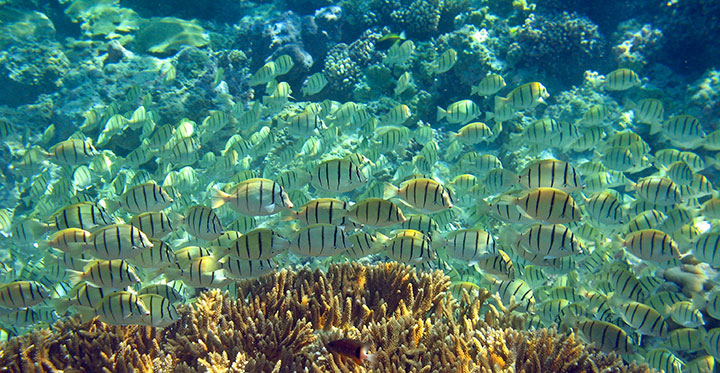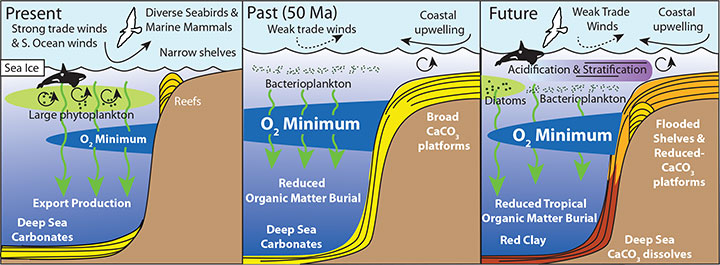Original story by Peter Spinks, Fairfax at The Age

Blue-green algae in Fishery Creek near Maitland in NSW. Photo: mkelly
First, the bad news: because of climate change and worsening water pollution, algae, the world's fastest-growing photosynthetic organisms, are proliferating worldwide. A few of these are of the toxic blue-green variety.
The good news is that some strains of algae can be converted into an alternative source of renewable energy that is commercially viable.
"Newly trialled native species provide real hope," says Evan Stephens of Queensland University's Institute for Molecular Bioscience and manager of the Solar Biofuels Research Centre.
"There are roughly 350,000 species of algae – more than all higher plants – around the world," he says. By isolating strains from native Australian waters, and then screening them against a set of criteria for producing fuel, scientists can breed new and improved varieties.
"By new strains, we mean algae varieties that have not been previously isolated, characterised and identified for fuels," Dr Stephens says.
Genetic engineering helps scientists determine traits that may improve yields and other qualities. "But in most cases we can go back and rescreen libraries of isolates for these characteristics which are naturally occurring," he explains.
Working with Germany's Bielefeld University and Karlsruhe Institute of Technology, the Australian scientists have identified fast-growing and hardy algae that could lead to cheaper and more efficiently produced biofuels.
Previous research concentrated on finding oil-rich algae. "Usually these are not fast-growing and are tastier to predators – like microscopic scoops of ice-cream," he says.
The resultant bio-crude oil can be processed in existing petroleum oil refineries, with no need for additional infrastructure. "This is important as new infrastructure is expensive," Dr Stephens says. "We can make the same things from bio-crude that we make from regular crude – namely petrol, diesel, aviation fuel and plastics."
A new frontier is in the biology and developing of new strains that grow stably, while exhibiting resistance to predators and temperature fluctuations.
Dr Stephens and his team identified hundreds of native species of microscopic algae from freshwater and saltwater environments around Australia. These were tested against thousands of environmental conditions in the laboratory, creating a shortlist of top performers.
The researchers are currently trialling the algae at a pilot processing plant at Pinjarra Hills, Queensland, which opened in April.
Traditionally, algae have been grown for health foods, aquaculture and waste-water treatment. In recent years, algae oil has become the focus of an emerging biofuel industry. Its production is still expensive, however, and viable commercial production has not yet been achieved in Australia or overseas.
"While we know that we can produce algae oil that is even higher quality than standard petroleum sources, we are working to increase the efficiency of production with the ultimate aim being able to compete with fossil fuels dollar for dollar," Dr Stephens says.
Algae in profile
Found anywhere from oceans, lakes and swamps to soils, rocks and icy mountain tops, algae harness solar energy to convert greenhouse gas into just about everything we need.
Algae accumulate up to 80 per cent of their dry weight in oil. Their biomass can double every eight to 12 hours, and they produce oil year-round, unlike most seasonal crops, says Aidyn Mouradov, a plant biotechnologist at RMIT University in Bundoora.
Algae are more productive, he says, than other energy crops such as corn, soy or oil palm. "For example, algae can produce 10 times more than palm oil and require 10 times less land area." This is important as biofuel crops have occupied valuable arable land that could otherwise be used to grow food.
Algae farming requires neither agricultural land – the micro-organisms can be grown on land too poor to use for traditional crops – nor clean, fresh water. "They thrive on saline, brackish and waste waters," Associate Professor Mouradov says, noting that they can be grown on excess nutrients in sewage waste water. "This leads to a win-win situation with a waste turned into an asset."
Finally, algae can produce a range of value-added products: ethanol, hydrogen, pigments, biopolymers and food for animals and humans. To top it off, they make great bio-fertilisers. "These are getting popular because they are eco-friendly and more cost-effective than chemical fertilisers," Professor Mouradov says.
Trials
Bunker fuel used by ships is highly polluting, so any attempt to replace it with algal oil would benefit the environment.
With this in mind, Maersk, the world's biggest shipping company, recently tested a mix of algal oil and bunker fuel on a ship sailing from Europe to India. The US Navy, meanwhile, trialled algal fuel on a decommissioned destroyer. Both experiments proved successful.
Several experiments using algal oil for aircraft jet engines have also shown promise.
And, in a move greeted with caution by GM sceptics, US biotechnologist Craig Venter, who first sequenced the human genome, plans to genetically engineer algal fuel that could be grown and harvested in the oceans.
Carbon guzzlers
As with all bio-derived fuels, algae remove carbon dioxide from the air as they grow. So the fuel produced is carbon-neutral.
This is different to burning fossil fuels, where carbon that has been locked underground for millions of years is put back into the atmosphere. If algae are recruited to make hydrogen, then one is taking carbon dioxide out of the air, and making a fuel that is carbon-free.
Algae are more versatile and adaptable than higher plants: they can be grown anywhere there is sunlight and water. Areas that are too dry, too hot, or too cold to support trees or other plants can still potentially be used for algae.
Farming potential
Deserts are an obvious place for algae farms, since the land cannot be used for much else and there is abundant sunlight. The issue there is providing water and other nutrients – nitrogen, phosphorus, potassium and iron. But this is not difficult using a closed system where the water is trapped, and cannot evaporate.
Challenges for algal farming include the mechanics of harvesting the algae, in post-processing – for instance, converting natural algal oils into biodiesel – and in the risk of virus contamination. All monocultures, whether plants, animals or algae, are unstable ecosystems, and are at higher risk of being wiped out by viral pathogens compared with complex multi-species ecosystems.
A variety of viruses are known to prey on algae; these could enter algae farms in water or by wind.
With plentiful sunshine and wide-open spaces, Australia is ideally placed to farm algae. Scaling up algae production for commercial use has been an issue since the early days of interest in algal production, says Susan Blackburn of CSIRO's Energy Transformed Flagship low cost algal fuels and head of the Australian National Algae Culture Collection.
Her research team has tested and characterised the diversity of algae for biofuels and other products. "We have a considerable database of characteristics," Dr Blackburn says. "Now we are developing a partnership with a multinational that wants to invest in R&D in Australia to take some of our strains forward."
CSIRO scientists have also developed high-production technologies for microalgae and they have economic models relevant for Australia, she says.
The best way to produce algae for commercial purposes, Dr Blackburn notes, is using photo-bioreactors that maximise the availability of light. "As well as light for growth, microalgae require nutrients rather like a hydroponics system," Dr Blackburn says. "Supplying the necessary nutrients in sufficient quantities is a challenge." One way to address this, she says, is to use municipal wastewater systems.
The CSIRO is developing a management system for algal fuels. "We also have a wealth of knowledge on Australian native microalgae and a bank of more than 1000 strains in the Australian National Algae Culture Collection," Dr Blackburn says. The collection also holds strains with potential for aviation fuel.
Aurora Algae, a US-based company, has invested in commercial algal production for biofuels in Australia. "It will surely be followed soon by others," Dr Blackburn says.
"If we devoted just 1 per cent of our land mass to algae farming, we could theoretically produce five times more oil than we currently consume and potentially become an oil exporter, rather than an importer," Dr Stephens says.
Facts and figures
Commercial algae productivity currently benchmarks at around 70 tonnes of dried biomass per hectare per year, Dr Stephens explains: ''Having said that, many species cannot achieve this.''
Sugarcane is one of Australia’s most productive crops, and also achieves 70 tonnes per hectare per year, but these harvests are measured in wet weight (in other words, 80 per cent moisture). So algae are about five times more productive than sugarcane. ''For sugarcane, much of the harvest is fibrous or woody biomass, compared to a relatively uniform and useable product when using algae,'' Dr Stephens says.
Although crop farming is unlikely to improve any time soon, global research efforts are raising total algae production efficiency towards the 4 to 5 per cent mark. ''This could halve, or slightly better, the 1 per cent of Australian land needed to produce five times Australia’s oil consumption,'' Dr Stephens says.
Algae cannot compete with solar photovoltaic or solar thermal energy just in terms of energy conversion, but electricity only represents 20 per cent of global energy consumption so the need for renewable fuels is currently greater.
''No single biofuel system can completely replace the current massive amount of petroleum used, so a suite of different biofuel technologies will be required,'' Dr Stephens says.
Links
Check out the presentation Dr Blackburn gave last year at: http://sapmea.asn.au/conventions/apcab2012/index.html
Discover what commercial products come from algae at: www.botgard.ucla.edu/html/botanytextbooks/economicbotany/Algae/index.html
CSIRO program details at: www.csiro.au/energy
Learn about the Australian National Algae Culture Collection at: www.csiro.au/ANACC
VCAA links
VCE Biology: www.vcaa.vic.edu.au/Documents/vce/biology/BiologySD-2013.pdf
AusVELS Biological sciences: http://ausvels.vcaa.vic.edu.au/Science/Curriculum/F-10
 THE reality of climate change, which is already dramatically affecting the distribution of marine life, will ultimately become impossible for humans to ignore.
THE reality of climate change, which is already dramatically affecting the distribution of marine life, will ultimately become impossible for humans to ignore.










